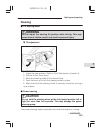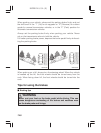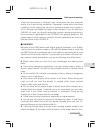
IMPREZA U.S.A. (E)
7
Starting and operating
7-29
– CONTINUED–
B When the brakes get wet
When driving in rain, in puddle or after washing the vehicle, the
brakes may get wet. As a result, brake stopping distance will be long-
er. To dry the brakes, drive the vehicle at a safe speed while lightly
depressing the brake pedal to heat up the brakes.
B Use of engine braking
Remember to make use of engine braking in addition to foot braking.
When descending a grade, if only the foot brake is used, the brakes
may start working improperly because of brake fluid overheating,
caused by overheated brake pads. To help prevent this, shift into a
lower gear to get stronger engine braking.
B Braking when a tire is punctured
Do not depress the brake pedal suddenly when a tire is punctured.
This could cause a loss of control of the vehicle. Keep driving straight
ahead while gradually reducing speed. Then slowly pull off the road
to a safe place.
J Brake system
B Two separate circuits
Your vehicle has two separate circuit brake systems. Each circuit
works diagonally across the vehicle. If one circuit of the brake system
should fail, the other half of the system still works. If one circuit fails,
the brake pedal will goes down much closer to the floor than usual
and you need to press it down much harder. And a much longer dis-
tance will be needed to stop the vehicle.
B Brake booster
The brake booster uses engine manifold vacuum to assist braking
force. Do not turn off the engine while driving because that will turn off
the brake booster, resulting in poor braking power.
The brakes will continue to work even when the brake booster com-
pletely stops functioning. If this happens, however, you will have to
push the pedal much harder than normal and the braking distance
will increase.


















